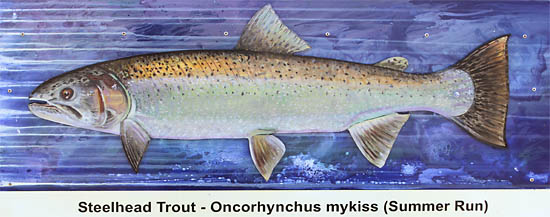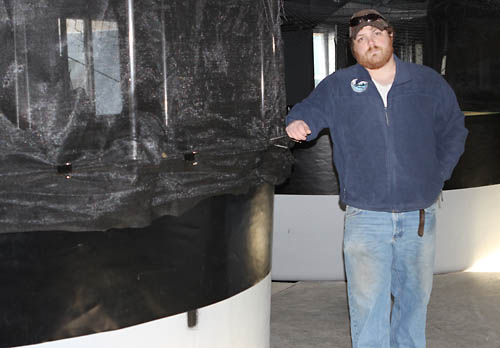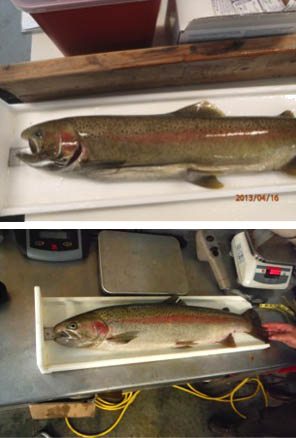home | internet service | web design | business directory | bulletin board | advertise | events calendar | contact | weather | cams

|
Kept Fish  Wording on this sign at the hatchery goes on to explain that steelhead are raised one to two years then released in the spring for the 600 mile journey to the ocean. The return rate has been between 0.5 and 3 percent. The Yakama Nation is trying to increase that by keeping wild-caught, spawned-out steelhead at the hatchery then releasing them at the mouth of the Methow River so they can return and spawn a second time without the long journey. Wording on this sign at the hatchery goes on to explain that steelhead are raised one to two years then released in the spring for the 600 mile journey to the ocean. The return rate has been between 0.5 and 3 percent. The Yakama Nation is trying to increase that by keeping wild-caught, spawned-out steelhead at the hatchery then releasing them at the mouth of the Methow River so they can return and spawn a second time without the long journey.Six steelhead resting in a tank at the Winthrop National Fish Hatchery will make local history sometime in November when the Yakama Nation releases them into the Methow River near Pateros. If all goes well, when the time comes, they’ll head right back upstream with schools of other steelhead returning from the sea and will spawn for a second time in the Methow River—but without going back to sea a second time. Unlike salmon—which return home only once to spawn, then die—steelhead, a large seagoing rainbow trout, can make the trip to sea and return home to spawn two or even three times, according to 30-year-old Matt Abrahamse, the fisheries biologist who is heading up the steelhead experiment for the tribe. But typically only 3 percent of a run makes it home to spawn a second time, he adds. He’s working to improve those odds so that the number of wild steelhead will increase by 10 percent in the Methow River.  Yakama Nation fish biologist Matt Abrahamse. Yakama Nation fish biologist Matt Abrahamse.“We’re creating a shortcut, basically,” says Abrahamse. The goal is to spare the fish the arduous, often lethal round trip past nine dams on the Columbia River and the hazards of ocean life, thus helping them survive to spawn a second time in the Methow. The reason for the tribe’s novel experiment is that steelhead are federally listed as a threatened species in the Upper Columbia and its tributaries, an historic fishery for the Yakama. This intervention may prove to be a way to increase steelhead survival rates so they can return upriver from Pateros to spawn in greater numbers, says Abrahamse. The six fish are wild, caught just below Winthrop, not hatchery raised. They have been anesthetized and had their eggs vacuumed out. They’ve been living in the tank—in a $500,000 building constructed by the tribe for this purpose with Bonneville Power Administration funding—for six months since that ordeal, rehabilitating. They’ve been outfitted with pit tags so their movements can be monitored as they pass submerged antennas that will register their upstream passage. They first were fed a diet of krill, then pellets to provide the fats needed for the female ovaries to recover and become ready to produce more eggs. They have been treated with antibiotics to combat parasites on their gills and with Formalin, a mild mixture of formaldehyde and alcohol, to prevent fungus. They’ve kept growing in the tank, one as much as four pounds, and they are now 25 to 32 inches long.  This wild caught steelhead gained 4.3 pounds while it was kept at the hatchery. This wild caught steelhead gained 4.3 pounds while it was kept at the hatchery.They’re survivors, which is what makes them valuable to the Upper Columbia Steelhead Kelt Reconditioning Project in the first place. (Kelt are spawned-out steelhead.) They’ve already made it through the Columbia River once, which suggests they likely have genetic material worth passing on, says Abrahamse. “We’re trying to replicate these genes in the wild.” To do that, he needs to add more fish to the experiment in coming years, ideally 100 to 125. Steelhead have adopted some clever survival tactics and are good at placing their genetic bets, according to Abrahamse. Some spawn every year, spending only a couple of months at sea. Others are “skip spawners” that spend a full year at sea or in estuaries, and then return to spawn. While some spend a year in saltwater, others spend a year in fresh water. “There are some that never go out to the ocean,” he adds. Nearly 80 percent of the steelhead that make it back to spawn a second time are females, he notes. Still, their survival stratagems have not kept them off the endangered species’ list. To get them off that list, the wild steelhead in the Methow River will have to return at an average rate of 1,000 for 12 years, according to Greer Myer, Natural Resources Program Manager with the Upper Columbia Salmon Recovery Board in Wenatchee. But that’s not all of it. Other criteria, such as their distribution and abundance throughout the Upper Columbia watershed, will determine if the wild steelhead have been restored to a viable species. Counting began in 1977, and to date, the targeted 1,000 wild steelhead (not to be confused with hatchery-raised sports fishery stock) have returned to the Methow only in the last two years. In 2010, 1,394 returned; in 2011, 1,562 returned. However, in 2012 it was close to target at 935, according to Myer. The tribe has a $500,000 annual grant from BPA until 2017 for the project, according to Ambrahamse. By that time, he hopes to have demonstrated that the technique, which was first used on Atlantic salmon, works and is worth pursuing. Myer says it’s already being used on steelhead in the Yakima River. She adds: “It’s very successful in the Yakima.” 11/8/2013 Comments
|